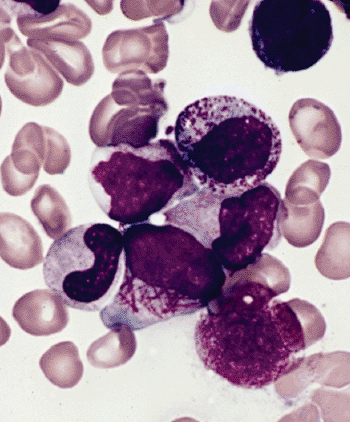Acute Promyelocytic Leukemia Rapidly Diagnosed by Immunostaining
By LabMedica International staff writers
Posted on 24 Dec 2013
Antipromyelocytic leukemia (PML) immunofluorescence staining is a known diagnostic tool for rapid diagnosis of acute promyelocytic leukemia (APL).Posted on 24 Dec 2013
Recently developed and commercially available, tetramethylrhodamine-5-isothiocyanate–labeled PG-M3 anti-PML antibody for APL diagnosis has been tested in a clinical setting.

Image: Bone marrow smear from a patient with hypergranular acute promyelocytic leukemia (Photo courtesy of the Armed Forces Institute of Pathology).
A team of scientists at the University of Texas MD Anderson Cancer Center (Houston, TX, USA) used immunofluorescence staining with the tetramethylrhodamine-5-isothiocyanate–labeled PG-M3 antibody to detect PML-retinoic acid receptor alpha (RARA) in bone marrow aspirate and/or peripheral blood smears from 30 patients with acute leukemia between February 1, 2011, and March 31, 2012. The results were compared with those of concurrent testing with our in-house polyclonal anti-PML antibody and with established tests.
For immunofluorescence staining, they used the tetramethylrhodamine-5-isothiocyanate (TRITC)-conjugated anti-PML monoclonal antibody PG-M3 (Santa Cruz Biotechnology, Santa Cruz, CA, USA). All APL cases showed a positive, fine and/or microgranular, immunofluorescence staining pattern, whereas non-APL cases showed a negative, chunky and/or macrogranular pattern. These results, which were available within two hours, were validated by testing with the polyclonal anti-PML antibody and with established cytogenetic and molecular testing methods.
The authors concluded that they had validated the utility of the TRITC–labeled anti-PML antibody PG-M3 for the diagnosis of APL. Their results indicate that immunofluorescence staining with this antibody is a rapid and reliable method for the diagnosis of APL. The study was published on in the journal Archives of Pathology & Laboratory Medicine.
Related Links:
The University of Texas MD Anderson Cancer Center
Santa Cruz Biotechnology













